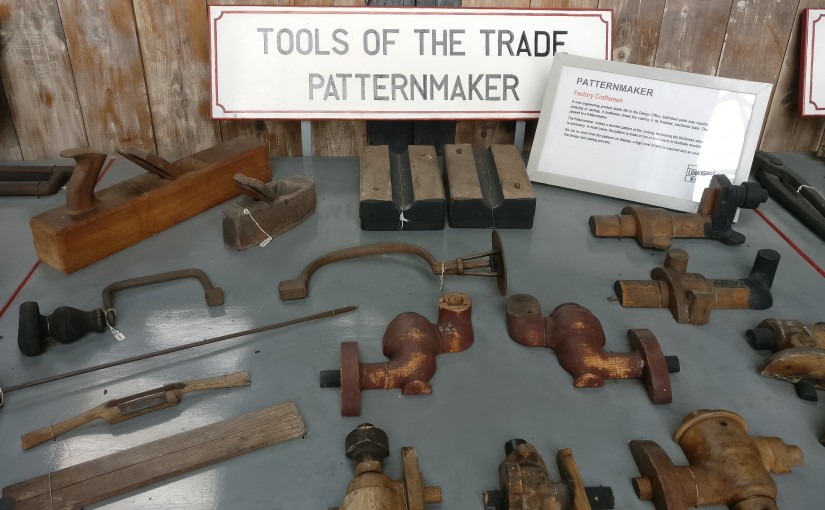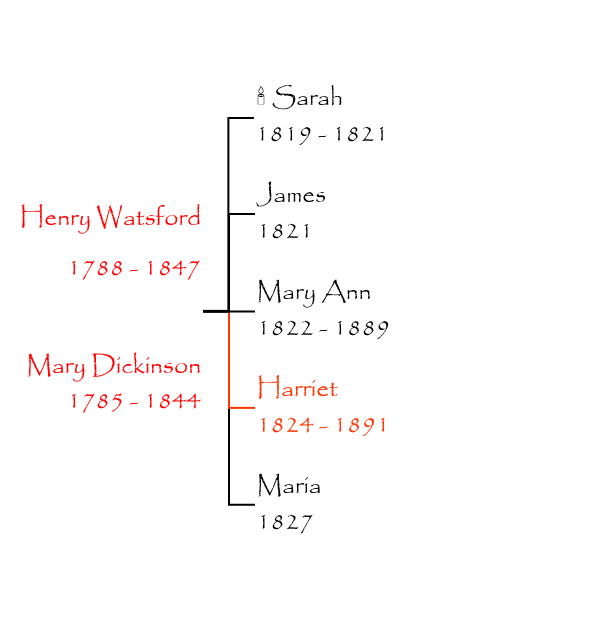This post is to give my family a brief overview of our shared direct ancestors. I will be posting stories about individuals and social history as well but I think an overview of the family is useful to be able to place the stories in context.
So I am going to start with my grandfather’s parents and work backwards as far as we have got in terms of the Leeming family. I have focused on going backwards purposely, and thus have not included details of the living family.
Grandad’s parents: Thomas Leeming and Mary Ellen Dunn
My grandfather’s parents were Thomas Leeming and Mary Ellen Dunn. Thomas and Mary Ellen were married in Manchester in 1919 and had three children; one of whom, Elizabeth, died in childhood aged five.
Grandad’s Mother Mary Ellen Dunn
Mary Ellen Dunn was born in 1885 in Salford the seventh of seven children born to Thomas Dunn and Elizabeth Carroll. Both Thomas and Elizabeth were born in Ireland and were both working in the flax industry (linen) when they married. Thomas Dunn was born in about 1843 in Ireland to Michael Dunn a gardener; Michael had died by the time Thomas married Elizabeth. I have been unable to trace any more of the Dunn family. Thomas Dunn had died by the time Mary Ellen was born. Elizabeth remarried in 1895 to Thomas Bryans. They had no children and she outlived him.

Elizabeth was born in Ardclogh near Celbridge, Kildare, Ireland to Patrick Carroll and Rose Cooney. Patrick Carroll (born 1816) married Rose Cooney (born in 1822) in Ireland and they had their first three children there before he and his family moved to Manchester between 1849 and 1951 (during the Irish Potato Famine). In Manchester he worked as a bricklayer.
Grandad’s father Thomas Leeming
Thomas Leeming was born in 1887 in Manchester the third child of seven and first son of Thomas Leeming and Eleanor (Helena) Quinn. Thomas worked at a Cold Store, as a Jeweller and as a Caretaker at a school.

Grandad’s Grandparents: Thomas Leeming and Eleanor (Helena) Quinn
Thomas Leeming and Eleanor or Helena Quinn were married in 1884 in Manchester.
Grandad’s great-grandmother Eleanor/Helena Quinn
Eleanor or Helena (both are used on various documents) was born in about 1856-7 in Manchester. She was the daughter of Michael Quinn and Mary Herring both of whom were born in Manchester. Michael and his two brothers David and Bernard were workers in the cotton industry. Michael’s father was also called Michael and worked in the cotton industry but this is as far as I have traced the Quinn’s backwards. The Herring family lived in Manchester for at least another two generations back. Mary Herring was the daughter of John Herring, Calenderman (operator of a machine that presses fabric between two rollers) (1794-1837) and Ellen Morton (1797). John was the son of Robert Herring, Hempmaker (1755-1825) and Jane Hart.
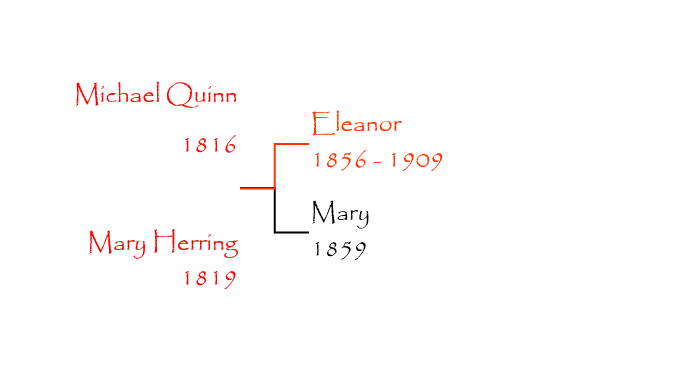
Grandad’s great grandfather Thomas Leeming
Thomas Leeming was born in 1858 in Manchester and worked as a Mechanic. He was the only son of Thomas Leeming and his second wife Harriett Herring nee Watson. Thomas has a large number of brothers and sisters from his parent’s first marriages. Four from his father’s first marriage to Mary Ann Ramsden and two surviving girls from his mother’s first marriage to Robert Herring.
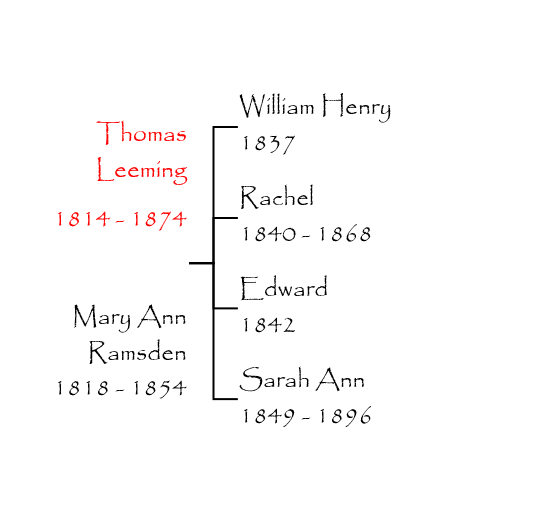

Thomas was the last child born to either of his parents. The couple also seem to have adopted (at least for a time) Annie Swindells from her infancy some ten years after Thomas’ birth.
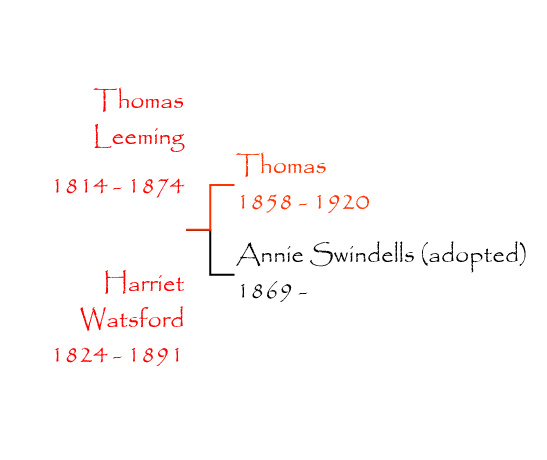
Harriet Watsford’s first husband Robert Herring’s sister Mary Herring married Michael Quinn (1816) and their daughter Eleanor Quinn (1856) married Thomas Leeming’s (1814) son Thomas Leeming (1858). So Eleanor (grandad’s grandmother) married the son of her uncle’s wife by her second marriage. The diagramme below might help….
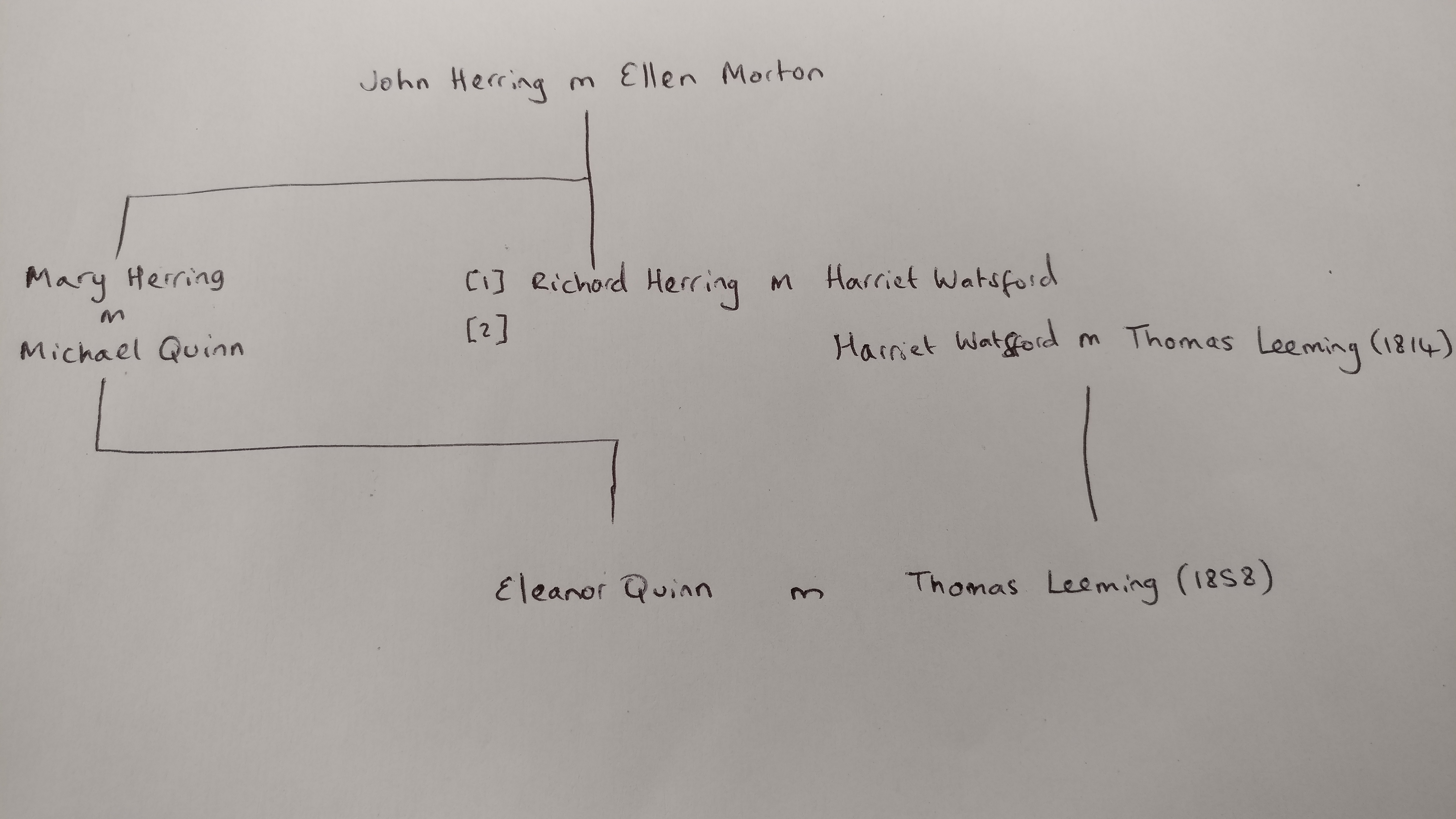
Grandad’s great grandparents: Thomas Leeming and Harriet Watsford
Thomas Leeming and Harriet Herring (nee Watson) were married in Hulme, Manchester in 1858. Both had lost their first spouses prior to their marriage.
Grandad’s great grandmother Harriet Watsford (1824 – 1891)
Harriet Watsford was born in 1824 to Henry Watsford and Mary Dickinson. She was the 4th child of five. Henry Watsford (1788- 1847) was from Sussex and had served in the 57th Foot Soldiers, Second Battalion. Henry signed up for service at the age of 16 for a period of 4 years. He served in Canada in the 1812 war (part of the Napoleonic wars). After his service he settled in Manchester and his profession is listed as a Labourer. Henry was the son of John Watsford (1763) and Elizabeth Shoulder (1764-1808) who lived in Sussex.
Grandad’s great grandfather Thomas Leeming (1814-1874)
Thomas was born in 1814 in Leeds and was a Pattern or Model Maker.
Pattern making was a skilled trade where wooden replicas of machine parts were made in order to form a cast into which molten metal would be poured making the required parts.
He was the first born child of nine children born to William Leeming and Sarah Scott. Thomas moved from Leeds to Manchester between 1842-1849.

Grandad’s 2x great grandparents: William Leeming and Sarah Scott
William Leeming and Sarah Scott were married in Leeds in 1814 and had nine children. William Leeming worked as a Model Maker and Joiner. A Model Maker was another term for a Pattern Maker. He owned at least a share of freehold houses at 3 and 4 Millwright Street, Leylands Leeds, which made him eligible to vote at a time when women did not have the vote and men only had the right to vote if they owned property.
Grandad’s 2 x great grandmother Sarah Scott (1794 – 1852)
Sarah Scott was born in 1794 in Bramham, Yorkshire which is a village in the Metropolitan district of Leeds, the third of the four children of Thomas Scott (1770) and Elizabeth Watson (1775) both of whom were also born in Bramham.

Grandad’s 2x great grandfather William Leeming
William Leeming was born in 1791 in Holbeck in Leeds. He was the son of William Leeming and Hannah Midgley. He had at least two brothers who died as infants. Hannah also had a child Sarah from before their marriage.
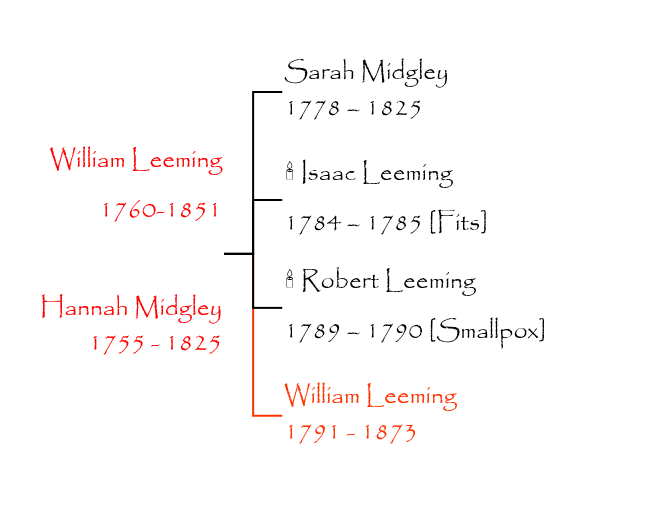
Grandad’s 3x great grandparents: William Leeming and Hannah Midgley
William Leeming married Hannah Midgley in Leeds in 1783, they had at least three children together. In the 1851 census William is listed as a retired Shoemaker. In earlier documents he is referred to as a ‘Cordwainer’ an old term for shoemaker. Hannah Midgley appears to have come from a Wesleyan family but I am still trying to untangle the many Midgley’s from the area. She died in 1825 and was buried at the Wesleyan Chapel in Holbeck.
Grandad’s 3 x great grandfather: William Leeming (1760 – 1851)
William Leeming was born in 1760 in Bradford; the son of James Leeming and Mary Killerby. He had at least one sibling who died in childhood.
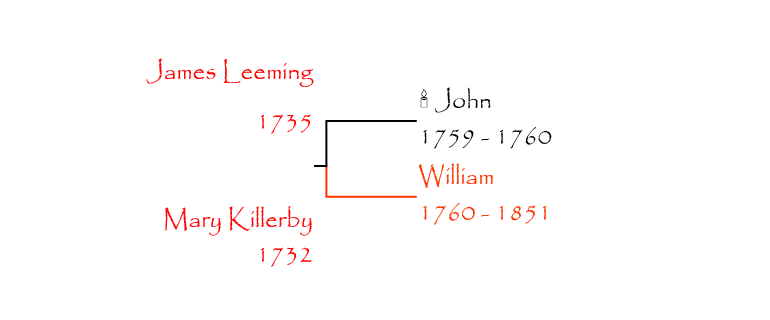
Grandad’s 4x great grandparents: James Leeming and Mary Killerby
James Leeming married Mary Killerby in 1758 in Bradford. James is listed on the marriage certificate as a Woolcomber.
Grandad’s 4 x great grandmother: Mary Killerby (1732)
Mary Killerby was born in 1732 in Bradford. The last child of eight born to Robert Killerby (1688-1746) and Ann Pullan (1688). Robert was the son of Michael Killerby (1649-1748) and was born in Bradford as was his father. Michael was the son of Robert Killerby and Margaret Roydes (Roades or Rhodes). Margaret Roydes (1618) was the daughter of John Roydes (1590) and Margaret Metcalfe (1600-1620) – grandfather’s eight times great grandparents. Hence we can trace the Roydes family back to 1590 in West Yorkshire.
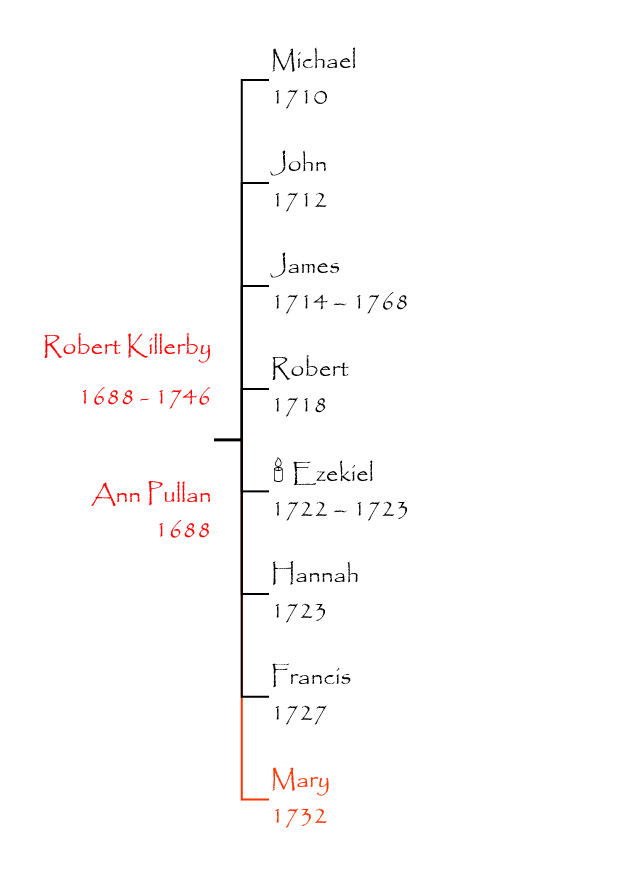
Grandad’s 5 x great grandfather: James Leeming (1735)
James Leeming was born in 1735 in Bradford; the son of Isaac Leeming and Sara Cordingley. He had at least two brothers and one sister.
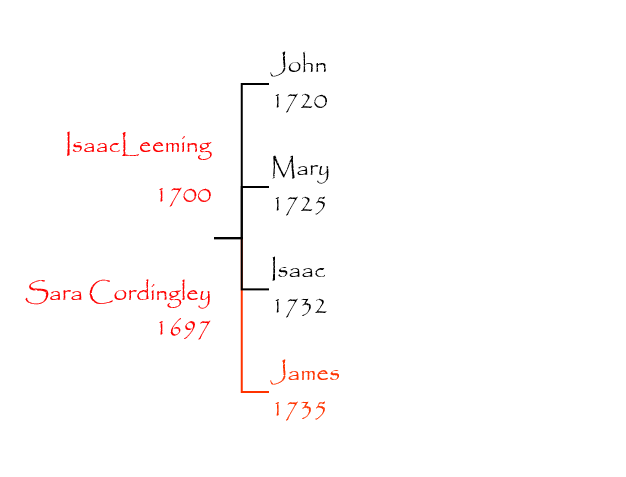
Grandad’s 5x great grandparents: Isaac Leeming and Sara Cordingley
Isaac Leeming a labourer married Sara Cordingley in 1720 in Bradford. They had at least four children. So far this is as far back as I have been able to get for the Leeming line.
Sara Cordingley was born in 1697 in Bradford to Henry Cordingley (1674) and Mary Joe. Henry’s father was called John.

Summary
The Leeming family moved from Bradford to Leeds to Manchester. Unusually they lived in towns and cities for at least 300 years and in some cases longer. They were involved in the early weaving trade. Shoemaking involved working with wood and these skills became crucial to the industrial revolution as pattern makers made the moulds for mechanised looms. From this they became mechanics but the shoemaking skills were retained in the family! There are many fascinating stories here and I look forward to discovering and sharing them with you all.
Advisory
Whilst I have made every effort to try and verify this tree it gets quite difficult tracing relationships for anyone who did not live past 1841 when the first census records are. Whilst some parish records give useful information such as area lived and occupation to help ensure you are following the right path others do not. I have used the best research methods I could with the information available, but this does not make it foolproof!
